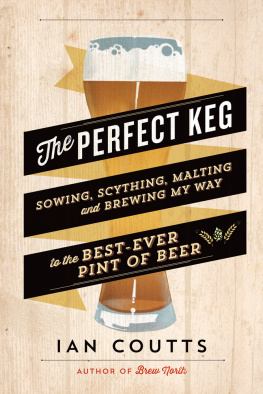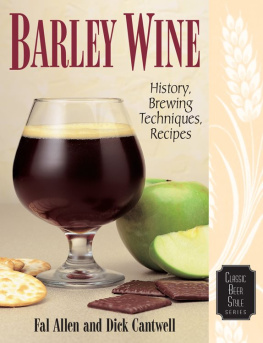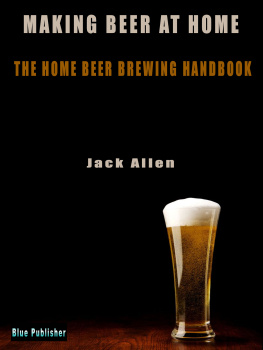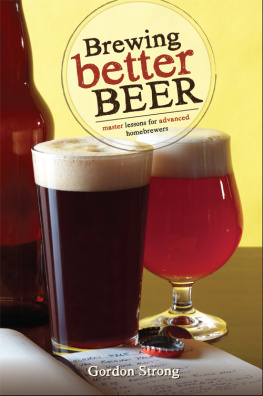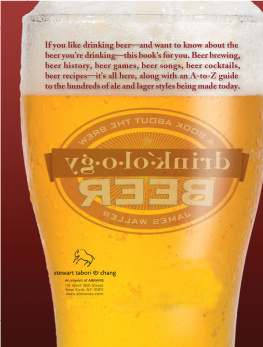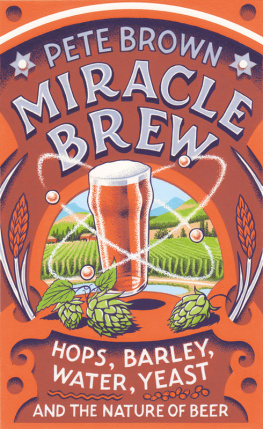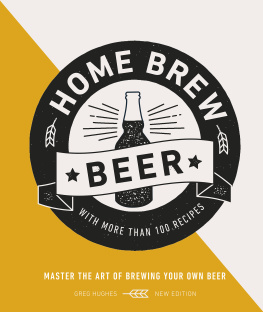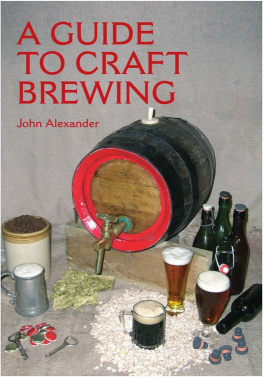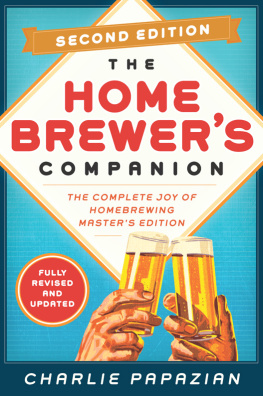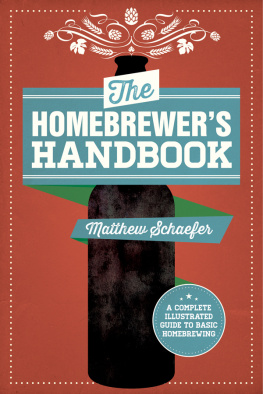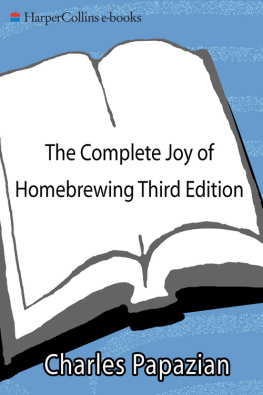One
YOU LOOK LIKE BARLEY PEOPLE

THE SCENE WAS like a bizarre remake of Hitchcocks Psycho. Psycho, that is, with my wife and me taking over Anthony Perkinss role and a bulky twenty-three-liter plastic bag of ale wort, the sticky, sweet fluid made by steeping crushed barley, standing in for Janet Leigh. We were supposed to pour the sticky brown fluid into a large plastic bin, which we had put in the old clawfoot bathtub of our Kingston house in case we spilled anything. Grunting and bickering, we had wrestled the bag onto the edge of the tub, pushed aside the shower curtain, and then tipped its spout over the plastic bin. Nothing. The spout would not spout. Grabbing a knife, we quickly poked a hole in the bag. A trickle. At this rate wed be holding the heavy bag in place for half an hour. So we gave it the full Norman Bates. We stabbed the bag again. And again. And again. Soon the sticky brown liquid was flowing into the bin from half a dozen holes, and into the bathtub and onto us. All that was missing were the screeching violins.
Not the most auspicious start. Here we were, undertaking the brewing equivalent of the bunny hill in skiing wed bought a beer kit at our local beer and wine supply place, a bag filled with five-plus gallons of wort and a little packet of yeast. All we had to do was get the wort into the tub, then toss in the yeast. And we were already in way over our heads. Couldnt organize a piss-up in a brewery? We couldnt organize brewing in a brewery.
AFTER MY INITIAL inspiration, Id left the idea of creating the perfect keg alone. Perhaps I hoped that, undisturbed in the quiet and darkness of my head, my idea would mellow and mature, rather like a fine English ale inside a wooden cask. By late winter, however, it was clear that, left to its own devices, the idea had developed all the richness of Coors Light. I had to get going.
Brewing great beer from scratch was going to mean learning two different jobs. First off, there would be Ian the brewmaster. I hadnt brewed beer at home in more than thirty years and when I had, the brewing hadnt amounted to much more than dumping a can of syrupy malt extract into a pot of boiling water. Our first recent attempt at brewing the great bathtub massacre, as I thought of it had actually worked out quite well, despite the personal hysteria we managed to inject into the process. It would have been quite hard to ruin our brew, working from a kit, of course. Not that I would have minded if we had if wed later been able to work out why. This was about learning. (And besides, no one ever died from drinking bad beer.)
This first brew and the several to follow were about learning to brew properly, to go at it in a systematic way. If we could learn to follow the simple steps needed to make beer starting from a kit, we could build on that and make progressively more complex brews, leading up to that final brew. The thing I realized early on about creating my perfect keg was that I didnt need to wait until I had my raw ingredients before I started brewing. In fact, I shouldnt. I could buy malt and hops and yeast, and equipment, and start learning to brew before I even had a seed in the ground. While everything was germinating or sprouting, I could get better and better at making beer. When my barley and my hops were ready, I would be, too. Itd be like hitting a baseball over your house, going inside, cutting out the leather and stitching together a glove, walking out the front door and seeing the ball drop into your hand. Just-in-time brewing.
Before we go any further, I need to digress a little to tell you about the ingredients in beer. This is a simplification, but at heart, beer comes down to four things: water, yeast, barley and hops. Fairly simple. But like the blues, another devilishly simple thing, with various tweaks and additions these base ingredients can give rise to an infinite series of variations.
Given how open-ended beer making is, its not surprising that there was plenty about brewing I didnt know. But in the parlance of Donald Rumsfeld, these gaps were known unknowns I knew that you had to put some hops into your brew at the beginning and other hops in at the end, I knew that you boiled the wort for an hour when making beer, even if I wasnt sure what kinds of hops or why exactly you boiled it for an hour.
With my other job, farming, I was on shakier footing. Its not that I wasnt aware that I was ignorant. I knew that. But I didnt know what I didnt know.
Well, I did know a couple of things. I knew I was going to need to plant hops and barley. For the hops, I had picked three different varieties out of a nursery catalogue Cascade, Willamette and Nugget. Hops, for the uninitiated, are what give beer its bitter taste. Generally, that is. There are other factors at play. And with hops, again very generally, the more hops you use, the bitterer your beer will taste. But not all hops are the same; some are naturally more bitter than others. Brewers define hops in terms of their alpha acid content, which is a measure of their bitterness, known as AAUs. Amateur brewers use a slightly different system to describe the same thing international bittering units, or IBUs.
Hops are about more than bitterness, however; they can also bring specific fragrances to the brew. Cascade hops are characterized by fruity and citrus-like aromas. Cascade is an all-rounder that has become popular in recent years in bitter so-called West Coaststyle pale ales. (The Cascade in their name refers to the Cascade Mountains, where they were developed in the 1950s. Most hops grown in North America come from the Pacific Northwest.) In terms of bitterness, Willamette is in the midrange along with Cascade. It is related to the classic British hop with the wonderful name Fuggles. Certain hops work in certain kinds of beer: Willamette would do in a more traditional British-style ale; Nugget might work when you wanted a far more bitter taste.
I chose three kinds of hops in part because I wasnt sure yet what kind of beer I wanted to brew. I had some ideas, but I didnt want to be nailed down so early in the project. I had another reason for mixing my hops. What I was doing was the hop growers equivalent of laying off side bets. I didnt know what would work best with my soil and weather conditions. If one strain of hop pooped out completely, the other two might pull through.
The flavors and aromas that hops bring to beer are so taken for granted today that it is sometimes hard to believe beer wasnt always made with them. Historically, brewers used just water, malt and yeast although for a good deal of history, people werent sure what yeast was. (Ill return to it later.) This brew was prone to going bad quite quickly, ruined by bacteria called Acetobacter, which turned the beer to vinegar about as fast as the yeast could ferment it. Beer was by turns sickly sweet or sour, so people fooled around with a lot of different additives for beer to improve its flavor, including plants such as juniper and heather. At some point in the ninth century, some German monks experimentally added the flowers from a hop plant to one of their brews and made an exciting discovery as well as giving the beer an interesting bitter flavor, the hop plants stopped the beer from going off. The use of hops in beer spread across Europe, though slowly, reaching England sometime in the fifteenth century. The parts of the hop you use to flavor beer resemble tiny, soft, pale green pine cones (they are in fact called cones). They have a pungent oiliness to them so that, when you encounter it in freshly picked hops, you seem to both smell and taste at the same time. The hop plant is a cousin of marijuana, and like marijuana there are male and female plants. The ones needed for brewing are the females the males do flower, but they dont produce the cones.

